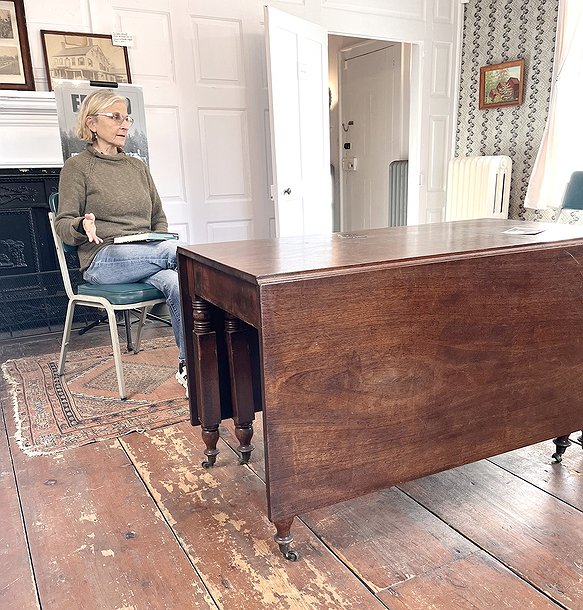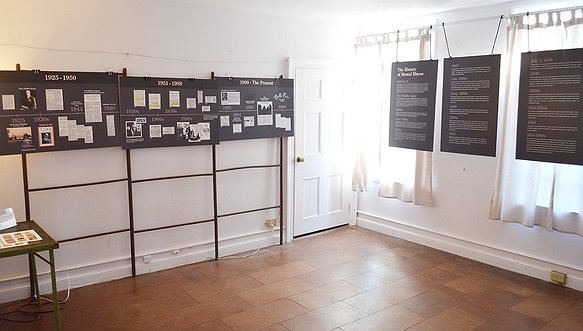Do you remember High Point Hospital?
October 31, 2024 at 12:06 a.m.
A few years after the BelleFair community was developed in 2000, Jodi and Bryan Wolkind moved in.
They didn’t realize they were living on the grounds of a largely unknown, yet historical spot in the community—not until an elderly taxi driver told Jodi during a trip home from the Metro-North train station that she resided on the property that formerly housed a psychiatric institution: High Point Hospital.
“Ever since then I was obsessed,” Jodi said. Largely, the fixation revolved around the mystery. There’s isn’t much, beyond its mere existence, that she knows about the institution. The only direct indication to be seen is the major road in the development, High Point Circle. But that means nothing without the context of the hospital—and you don’t know what you don’t know.
If you’ve never heard of High Point Hospital, you wouldn’t be alone. Try Googling it—there isn’t much to learn, certainly not from reputable, official sources.
The Wolkinds’ interest brought them to join like-minded folks at the Bush-Lyon Homestead on Saturday, Oct. 26, where the Port Chester Historical Society in conjunction with an accomplished documentary filmmaker opened an exhibit dedicated to the facility.
Operating from 1951 to 1995, the privately-owned hospital served as a long-term, inpatient facility treating people with mental illnesses.
Globally, the history of medical treatment in the world of mental health is dark—from lobotomies to electroshock therapy to the overuse of lithium treatment. And the science toward improvements still lags. In September of this year, the Food and Drug Administration approved the first new antipsychotic treatment in decades, advancing medication known to have severe side effects for patients.
For decades, the impacts of that checkered history were seen in the Port Chester and eventual Rye Brook (incorporated in 1982) communities through the presence of High Point Hospital.
Jill Yesko, a documentary filmmaker, approached the Port Chester Historical Society last year because her current project—one personal in nature—seeks to uncover truths and mysteries around the hospital. Facing an unexpected struggle in finding information, she had hoped the organization would have some gems to potentially share.
Kikki Short, a Historical Society director, said their inability to help was exactly why she wanted to get involved.
“When the request first came in for information, to see if we had booklets, brochures or books, I said, ‘I don’t know what you’re talking about,’” Short said. “I had never heard of High Point Hospital, and we have not one thing. It’s kind of striking.”
It was particularly peculiar to her because of the natural comparison to their United Hospital records. The Historical Society has collected nurse yearbooks and newspaper articles about United, they’ve been able to put together a timeline and speak to former employees with ease.
“This is such a different story,” Short said.
With different angles in mind, Yesko and the Historical Society have been researching High Point Hospital for around a year, and with grant funding from Humanities New York were able to put together an exhibit to share with the community.
For Yesko, the story started when she was a child in New Jersey.
“I was 9 years old, my brother 7, and one day my mom is gone. We have no idea where she went; nobody talked about it,” she said during a talk at the exhibit’s opening day. “My mom was at High Point I believe for a little over a year.”
Sally Yesko was a patient in 1967 and 1968. The experience Jill referred to was not uncommon—mental health issues were not understood, they were stigmatized, and therefore were often handled in secrecy.
She remembers, once, visiting her mother in the old, majestic estate that housed the facility. The gated entrance and long driveway to the mansion felt, she described, medieval. During the visit, she wasn’t able to interact with her mother for long.
“After that, life just went on. And then one day, Mom came home, and that was a great thing, but she wasn’t the same,” Yesko said. “My mom was a redhead, freckled, vivacious, full of love. She had a great figure, loved to dress to the nines. When she came out of the hospital, she was fat, she slept a lot. We couldn’t understand what happened to our mom. And life did not go well for my mother or our family after that.”
The trauma was reignited in 2020. Sally was in an assisted living facility in Florida, where she contracted COVID-19 and died. Her children were not allowed to see her; Yesko had to say her goodbyes on the phone. It felt all too familiar.
“I thought a lot about Mom during COVID,” she said. “And this episode from my childhood was like a pea under the mattress. I felt compelled to try and understand what happened to my mom during that time and do everything I could do to discover that.”
The research process led to her current making of “Erased,” a documentary following Yesko’s journey toward trying to piece together what happened at High Point Hospital, specifically to her mother. The title has multiple implications, she explained in a later interview.
Her mother as she knew her was gone, patients who stayed for years were forgotten in their communities, and records of the institutions are unattainable—Yesko has hounded the state and county in search of documents to no avail. And similarly missing are recollections of its existence in the local community.
While records are difficult to find, Yesko has been able to talk to several former patients and staff members, and many of the stories she’s heard are gruesome. Decades ago, homosexuality and marijuana use could call for a mental illness diagnosis comparable to schizophrenia. At High Point, she said, it wasn’t uncommon to see children admitted, and many stayed for long periods of time—at least a few months, if not years.
Many of the anecdotal stories Yesko has heard speak to abuse or describe best practices of the time that would now be considered barbaric.
“Will I ever be able to understand what happened to my mom? No. I’ve come to that realization. Will this process bring me closer to healing? Maybe,” Yesko said. “But I do feel a tremendous obligation to the patients I’ve spoken to and the former employees…they say if you forget about history, it will repeat itself. We cannot let that happen.”
The work of the Historical Society, Short explained, was more about researching the property and connecting High Point Hospital to the context of history of the field.
“To me the most interesting thing is the history of treating people with mental illness, it tracks with so many other things,” she said. “It shows the ways we looked at individuals and the kind of civil rights we inherently had.”
“The exhibit is really about High Point Hospital and putting it into context.”
Side by side timelines offering the history of mental illness treatment and perceptions and a record of known events at the now BelleFair property do just that.
Before High Point opened, the 142-acre property known as Hilholme was owned by the prominent, monstrously wealthy, Straus family. For reasons and methods unknown, the estate was acquired by Dr. Alexander Gralnick in the late 1940s, and he, a psychiatrist, opened High Point Hospital in 1951.
Through Gralnick’s publications and found job advertisements, the Historical Society and Yesko have gotten peeks into the philosophy of running the institution over the decades. The psychiatrist devoutly believed long-term care was crucial, as well as limited family interactions. The driving belief, his own book details, was that doctors know what’s best for patients and are responsible to treat them as necessary despite resistance.
In the 1970s, there was a large push in New York State to deinstitutionalize mental health facilities, yet High Point didn’t close until 1995. Yesko believes because it was private, “it was a different animal.”
“My gut tells me there was so little oversight at High Point,” she said. “Anything could have happened there.”
It’s unclear why the hospital ultimately closed when it did, and a fire deemed suspicious a few years later added to the mysteries. Yesko wonders if that’s where some of the missing records died.
The High Point Hospital exhibit at the Bush-Lyon Homestead shares timelines, newspaper clippings and first-person testimony about the experience of being at the hospital. It also highlights insight into the philosophy of Dr. Gralnick’s practices.
The exhibit will be available to be viewed by appointment only at the Bush-Lyon Homestead through the end of November. Email [email protected] to arrange a time to visit.
When Yesko finishes the film, Short said the organization plans to set up the exhibit again. Around that time, there will also be a screening of “Erased.”






Comments:
You must login to comment.